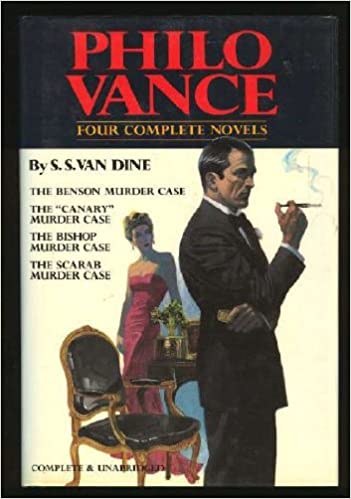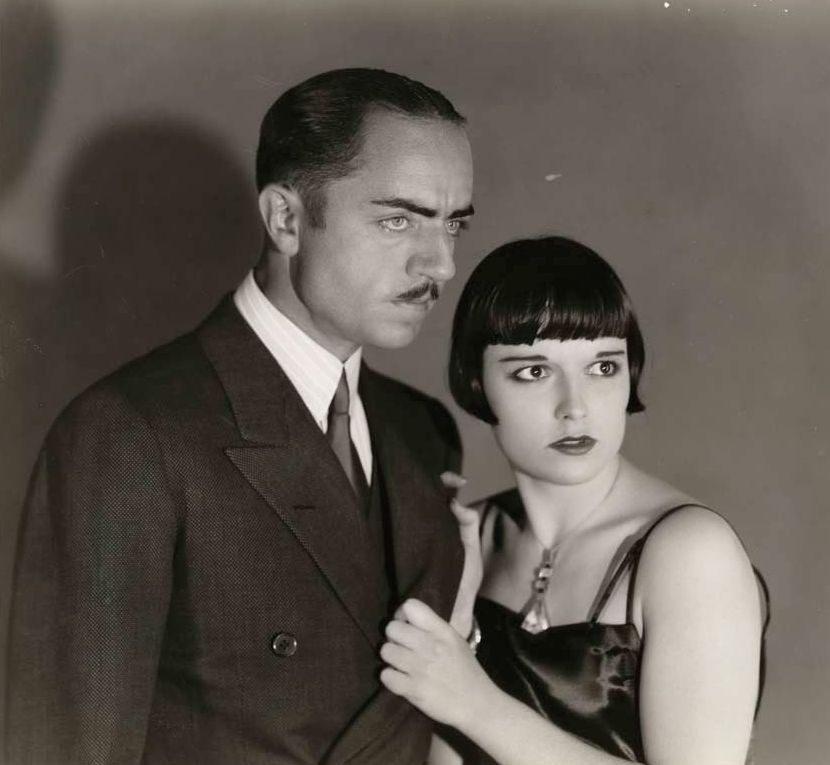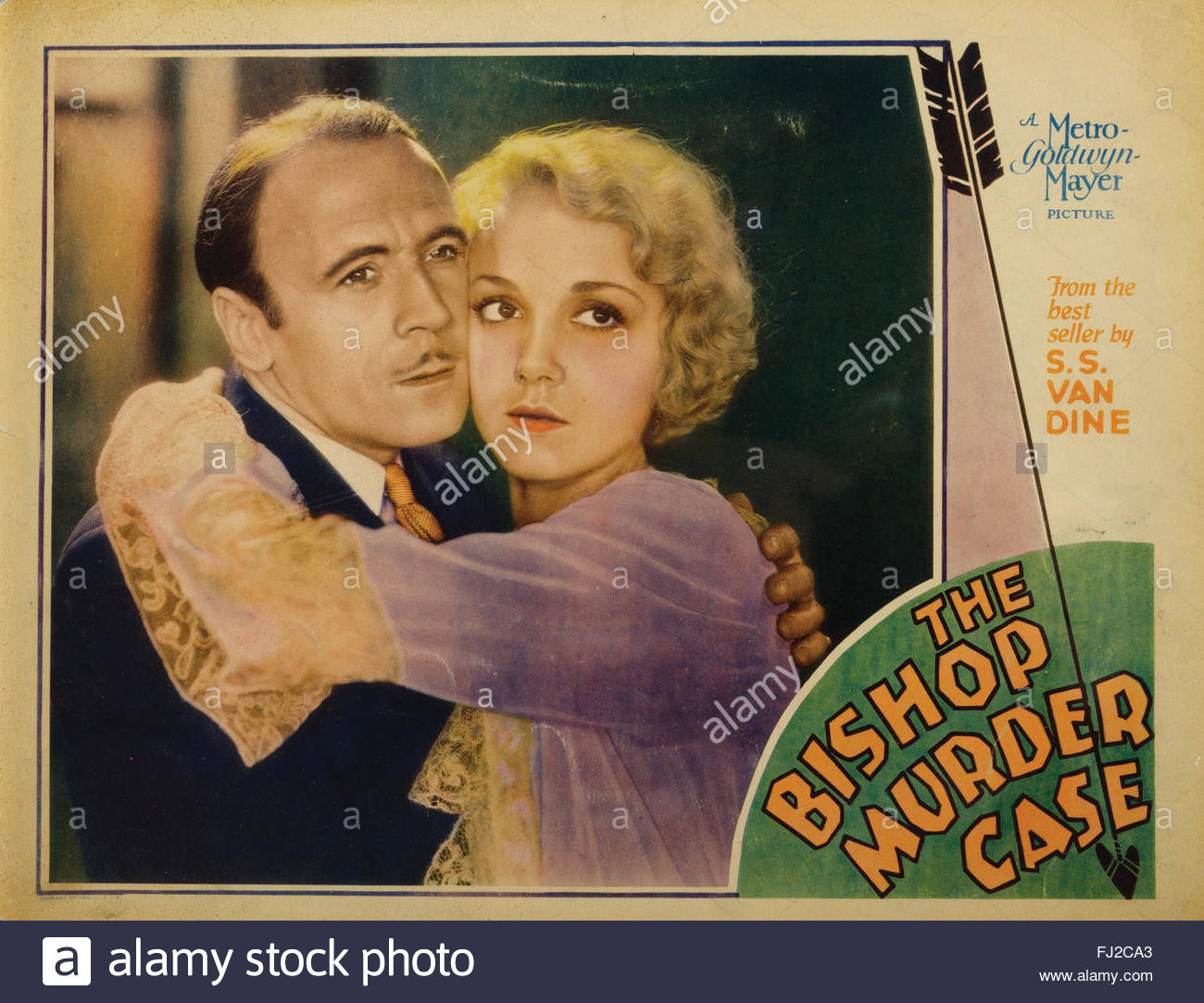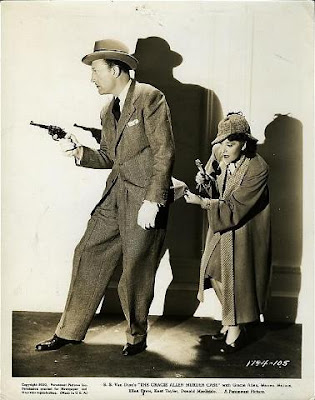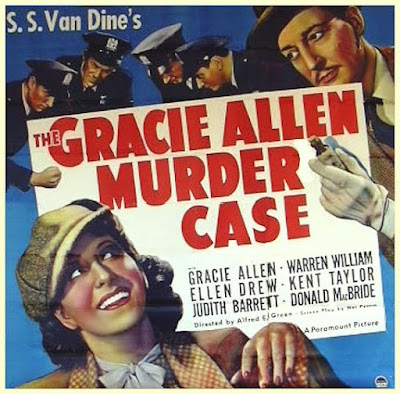From 1926 to 1939 S.S. Van Dine wrote 12 murder
mysteries with his detective Philo Vance. They were enormously popular and
though I gave it my best I could not get through the one I tried. The language
feels very stiff and formal and Philo is a bit of an annoying somewhat foppish
snob. A series of 15 films based on the books was produced from 1929 to
1947 with a number of different actors playing him – a few who would go
on to some fame. I was able to find and watch 13 of them. The other
two may be lost. I can’t honestly say these are all that great never rising
above B films but I have a weakness for these old detective series.
S.S. Van Dine was the pseudonym for Willard Huntington Wright, born into
a well to do family in 1888 along with his brother Stanton, who was to become
a top painter during the early 1900’s. Willard was an aesthetic, a dilettante
in many of the arts, an erudite, a would be poet and philosopher. He loved
the intellectual world and society of writers and thinkers. He had high
ambitions that he would become one of them but that wasn’t where he found
his fame. For years he took on various writing jobs for magazines – an editor,
a reviewer of films, an article writer on demand. But none of them took
him to where he wanted to be – a literary lion. He became depressed – something
that would stick to him all his life – and when he began having fits he
took to opium and became an addict. His mother sent him to France to enter
a sanitarium to cure him and while there he read nothing but detective novels
– hundreds of them.
He came away from that experience cured but also sure that he could write
mystery novels and created the character Philo Vance who in many ways was
much like Willard – snobbish, intellectual, confident of his abilities and
able to solve crimes through psychology as much as clues. He took on the
name of SS Dine because the initials reminded him of travel and the last
name of food. He did his best to keep his real identity a secret because
he was a bit embarrassed by his very commercial books. His first book was
The Benson Murder Case (1926) and right from the moment of being published
it was an enormous success. As were the Philo Vance novels that followed.
He became very wealthy and eventually his real identity was revealed by newsmen
who figured it out. Willard was to write until he died. One of his book reviewers
was Dashiell Hammett who hated them – upper class twits in manor houses
that was all the rage back then – and of course he was to change the direction
and style of murder mysteries to something rougher and realer.
The Canary Murder Case (1929) – 5.0
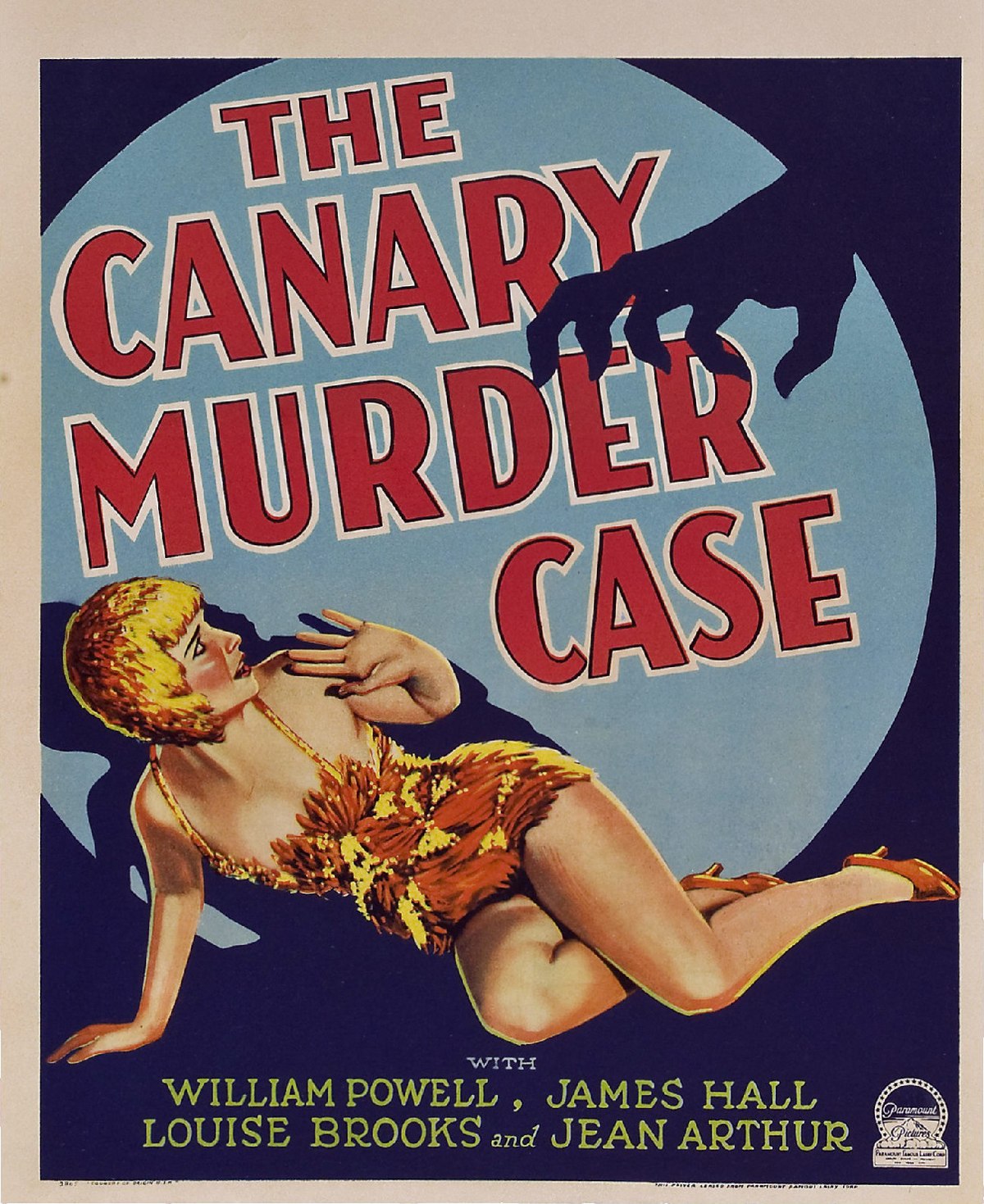
Paramount took out a contract on three of the Vance novels and looked around
for an actor to star in them. William Powell had been kicking around in
silent films for about five years without a lot of success, usually playing
dastardly villains but through pure luck Paramount chose him and that was
of course just the break he needed. He was to do two others for Paramount
before jumping to Warner Brothers where he did one more Vance film - The
Kennel Murder Case - in 1933. Then he moved over to MGM and gained his fame
with the Thin Man series and one can speculate that his role as Philo Vance
had a lot to do with him being chosen - and thank God for that. Interestingly,
the wonderful frog-voiced Eugene Pallette also somehow managed to show up
in all four of Powell's Vance films.
Showing up here is a young Jean Arthur who also had been having little
success in her career thus far after slogging through a number of silent
films and into talkies. She gained a reputation as a terrible actress but
she kept plugging away but it really wasn't until the mid-30's after The
Whole Town is Talking and Mr. Deeds Goes to Town that she became a star.
And of course there is the appearance of the legendary Louise Brooks who
made two silent films in the same year as this one that cemented her legendary
status - Pandora's Box and Diary of a Lost Girl both directed in Germany
by G.W. Pabst. So it is very odd and unexpected to come across her in this
mediocrity - and I see that her voice was dubbed - I was horrified that Louise
Brooks spoke with a twangy Brooklyn accent - but that is not her. She never
made it in America though and her last film which I saw a few months ago
was a 1938 low-budget John Wayne western called Overland Stage Raiders.
Other than this, the film - and the copy quality I saw was awful - is very
much stuck in place with bad acting, bad stage direction and bad sound as
the talkies were really just getting underway and in that period the technology
was really not around yet for the actors to move and be able to capture
the sound well. In fairness to the film it began production as a silent
film and then it was decided that it would be a talkie. By the time they
had made this decision Brooks had filmed her parts and gone to Europe – thus
the dubbing. For reasons unknown, the character of Vance is changed to a
large degree – gone is the supercilious style and phony English accent –
he was now William Powell at his most serious and dull. Not so much
his real social life. Apparently, Powell and Willard became drinking buddies
and used to go around to all the places of ill-repute. What would Myrna
Loy think!
The Greene Murder Case (1929) – 5.0
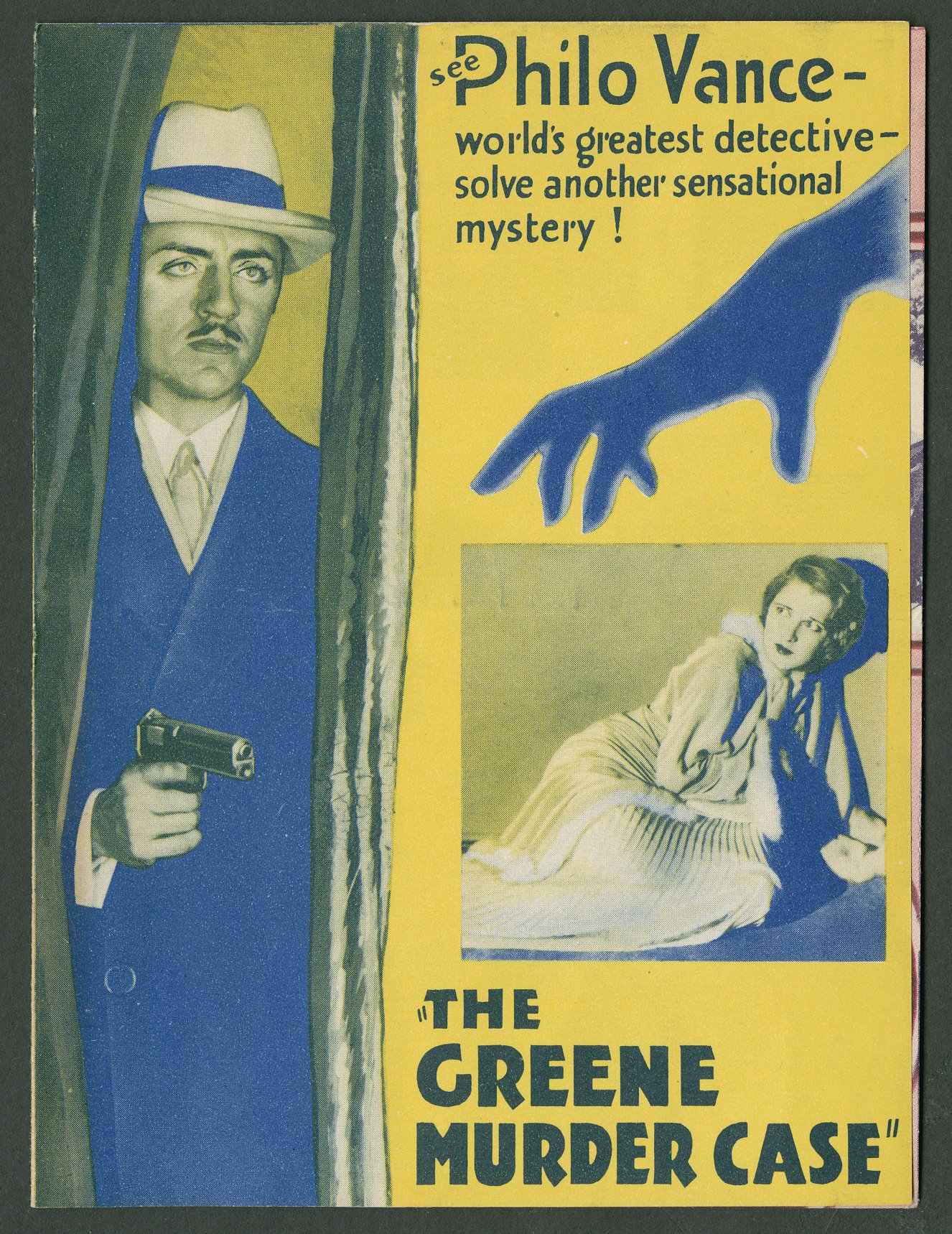
This and the previous Philo Vance film, The Canary Murder Case, must have
been made around the same time I expect but released at different times.
In Canary they mention the Greene case and in the Greene Murder Case they
make mention of the Canary Murder Case. In the series of 12 novels by S.S.
Van Dine The Canary Murder Case was written first. Both films were released
in 1929 and both suffer from the new transition to sound. Also, as far as
I know there are no good quality versions available and so the viewer has
to suffer through both bad sound and murky video. Both also star the very
young Jean Arthur but in different roles as well as William Powell as Vance
and the great character actor Eugene Pallette as the one step behind policeman.
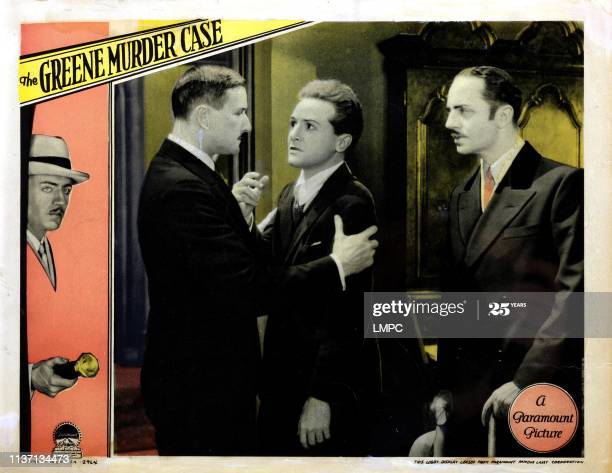
This one has a lot more dead bodies then The Canary thus making it a bit
more intriguing and director Frank Tuttle showed a little more camera movement
- even at one point oddly shooting the roof top from across the street -
he was to go on to a solid career with perhaps This Gun for Hire being his
best-known film. He also directed the next Philo Vance film The Benson Murder
Case. And he too became a drinking partner of Powell and SS Dine. The murder
case revolves around one of those complicated wills that almost ensure murders
will ensue. The money is spilt among the wealthy Greene family but if they
should die, then their portion comes to the others in a family in which
everyone already hates everyone else. With the will as an incentive, the
bodies begin to drop.
The Benson Murder Case (1930) – 6.0

This one is an improvement from the two previous Philo Vance films. Again
starring William Powell but with a little bit more pep and wit about him.
The crime is reasonably well done with a house full of suspects and what
would seem an impossible murder but murder it is. The film is set in 1929
and the markets are collapsing and people are losing everything they have
with ill-advised margin calls. Their broker is Anthony Benson who seems rather
cavalier about his client’s losses and so gives them all a motive to kill
him. Later that night they all show up independently at his house in the
country and being a good if not too bright host he invites all these people
who wish him dead to stay the night. That won’t end well.

Eugene Pallette is back as a policeman adding a few laughs and Paul Lukas
is one of the suspects. Lukas is at the beginning of his Hollywood career
after coming from Europe and he would not become a star for a few more years.
He actually takes on the role of Philo Vance in The Casino Murder Case in
1935. One last name might be familiar to many – William Boyd – but not the
Hopalong Cassidy William Boyd. This one got into trouble with drugs and
the cops and the newspapers got him confused with Hopalong badly damaging
his career for a while!
The Bishop Murder Case (1930) – 5.0

The Philo Vance series was picked up by MGM after Paramount did two of
them with William Powell, but unfortunately the film is as static and stagey
as were the Paramount films. In this one Philo Vance isn't exactly the smartest
guy around as pretty much every suspect has to be killed before he figures
it out. Vance is played by a very natty and saturnine Basil Rathbone nearly
a decade before he became famous as another detective. Amusingly - from
today's perspective - one character keeps referring to him as Holmes and
the D.A. as Watson. But even more so if you have read any of books from
the pen of S.S. Dine who wrote 12 Philo Vance mysteries. It is quite obvious
that Vance is modeled very much on Holmes and even has his Watson type narrator,
his friend and lawyer Van Dine who at least up to this point does not show
up in the films. There is an instance in the film when Philo looks at a
man and tells him what he was up to the night before including that he didn't
have the money to pay a bill. Very Sherlockian.
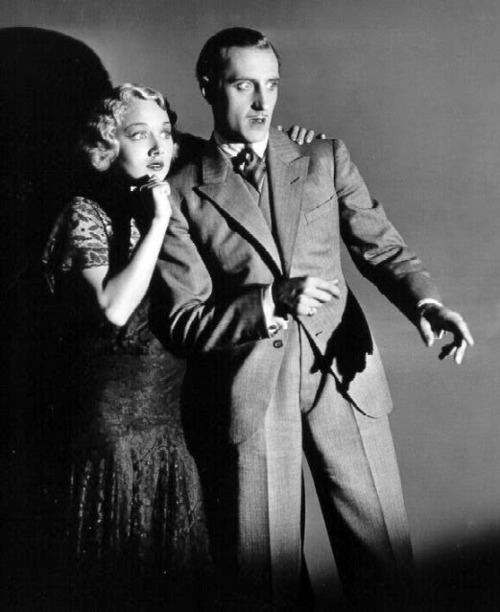
Most of the supporting actors over play it like they are a third rate theatrical
group on the road. Rathbone and one of the suspects, Roland Young, seem
to be in a different film than the others acting wise. That includes Delmer
Daves who some 13 years later began a very solid directing career -
among his films were Destination Tokyo, Dark Passage with Bogart and Bacall,
Broken Arrow and 3:10 to Yuma. His last directed film was in 1965. He has
only a small part but is quite bad in it.
A man named Robin is found in the enclosed garden of some wealthy homes
- with an arrow stuck in his chest and a note in the mailbox about Cock Robin.
The nursey rhyme about him says:
Who killed Cock Robin?
I, said the Sparrow,
with my bow and arrow,
I killed Cock Robin.
And this begins a series of murders all with nursey rhymes attached such
as Humpy Dumpy fell off a great wall. Vance is brought into the case as
one after another of the suspects gets rhymed to death. By the end there
are only a few left to choose from. Rathbone is fine here in what I think
was only his second talkie and an early one for Roland Young who already
seems to have his droll style of speech down.
The Kennel Murder Case (1933) – 6.5

This is a giant leap forward from the previous Philo Vance films. Part
of that is simply a reflection of how quickly films were technically progressing
from those earlier films made just as sound came in, part of it is a much
better script, a more relaxed William Powell and of course the direction
of the great Michael Curtiz. Curtiz had already made a large number of films
in his native Hungary and other countries in Europe before moving to the
USA in 1926 where he immediately began directing, but it wasn't really until
he teamed up with Errol Flynn in Captain Blood in 1935 that he became well-known.
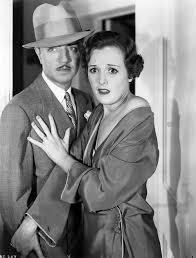
Powell was one year away from the Thin Man but many of his Thin Man trademarks
are in place - the same look, the same sharpness and even a small dog that
we first meet at a dog show. The film Philo Vance character is very different
than the book one. In the book he wears a monocle, is an English accented
dilettante and quite smug. Thankfully, the films took some liberties. After
the film Warner Brothers reduced the salary of Powell from $6,000 to $4,000
a week and Powell objected. Warners blamed it on the Depression but also
didn’t think Powell was worth it – so they came to an agreement that Powell
could get out of his contract and leave Warners. He entered into contract
negotiations with Columbia but in the meantime made a film with MGM called
Manhattan Melodrama in which he was teamed up with Myrna Loy. The film did
well – it also had Gable in it – and W.S Van Dyke the director saw magic
and put Powell and Loy into The Thin Man. And MGM bought out Columbia’s contract.
A lucky break for Powell and Loy.
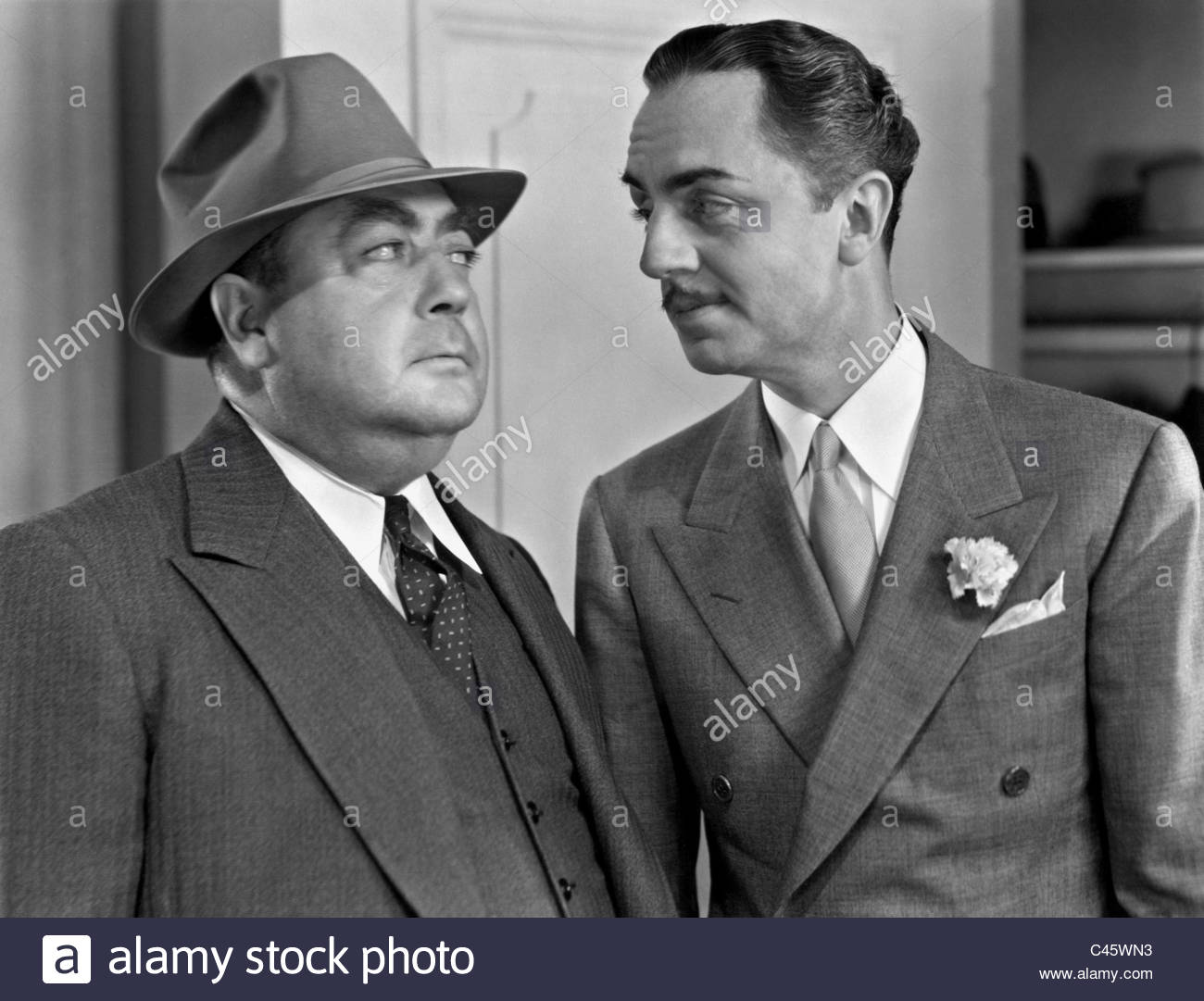
It is a good film with a bunch of suspects and a fairly complicated locked
door murder and the lovely Mary Astor. When Powell gives his rendition of
how these complicated murders all took place, it is like a puzzle coming
together. He is in top form - so much better than in his early talkies. Powell
is teamed up with Eugene Pallette again here. Pallette had played the bullfrogged
voiced Sgt Heath in three previous Philo Vance films with the last one with
Powell being The Benson Murder Case in 1930. When they meet each in this
one, they give each other a smile and say its been a long time since we saw
each other. With Powell leaving the studio, Warners had to find a replacement.
The Dragon Murder
Case (1934) – 5.5
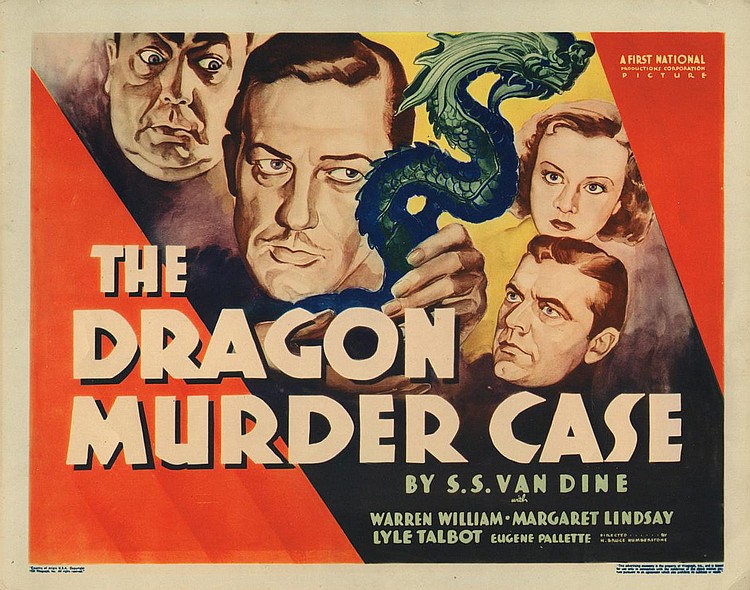
I seem to be running into Warren William a lot as of late - as Perry Mason,
in the Arsene Lupin film, in the Lone Wolf series. He was quite popular
in his time and could easily switch from good guys to bad guys with that
slightly wicked look he had. Here after two others played Philo Vance -
William Powell and Basil Rathbone - William takes on the role for two films
- though other actors played the role in between his portrayals. His other
Vance film is the1939 lost The Gracie Allen Murder Case. Warners was also
having trouble finding a director. A few of them looked at the script –
Curtiz, Archie Mayo, Mervyn LeRoy and Alfred Green but they all gave it
a big no. So did H. Bruce Humberstone until Jack Warner called him into
his office and said direct this film or I will make sure you never direct
another one. Humberstone accepted and much to his surprise the film
was a hit and tropical fish that he featured in the film became a craze.
In the books Philo Vance is a wealthy dilettante who is friends with the
DA and tags along on cases usually involving the upper class, always solving
them with his psychological insights. In the films he is more a traditional
detective looking for clues. This one is decent enough - a lot of suspects
and it moves along. As in most of the Vance books, it appears on first impression
to be an impossible murder but murder it is. In this instance, a group at
a house party go swimming in a natural pool - the Dragon Pool and one of
them doesn't come up. And when the pool is drained the next day he is nowhere
to be seen. No one liked him, not even his fiancée so there are plenty
of suspects. The killer comes as no surprise if you apply basic film technique
detection skills!

Eugene Pallette picks up again as Sgt, Heath even with a switch of Philo
from Powell to William. He has some good zingers in this one and as nearly
always the film ends with Heath saying to Vance, "We solved another case
didn't we". In the cast also is Margaret Lindsay, Lyle Talbot, George Stone
and Dorothy Tree (Confessions of a Nazi Spy, Nazi Agent, Hitler Dead or Alive)
who later on became a famous voice teacher.
The Casino Murder Case (1935) – 6.0
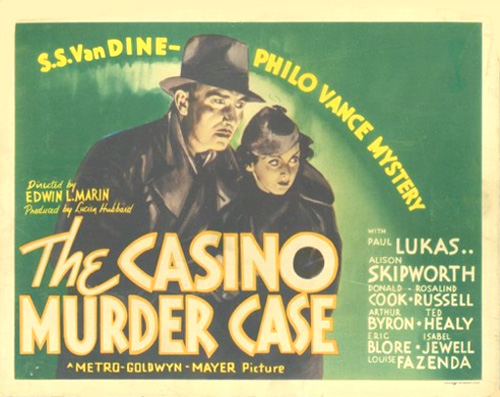
I kept thinking through this film that the actress sure looks a lot like
Rosalind Russell and what do you know, it was! I just know her for her roles
from a few years later on such as The Women and His Girl Friday where she
looks older. The Philo Vance films seem to be bouncing back and forth between
MGM, Paramount and Warner Bros. for some reason - I would guess the studios
were buying specific books from S.S. Dine rather than rights to the character.
This one is MGM and they make a peculiar choice for Philo - Paul Lukas -
a Hungarian who always sounds French to me - who moved to the USA in1927.
Once you get used to the accent he is fine and he has solid chemistry with
Rosalind.
Not as complicated or clever as some of his other cases, this feels a bit
lazy in the plot. It seems that Philo’s previous cases are in book form
and Rosalind’s character remarks that she has read them all – but skipped
the parts where he gets too wordy – which is rather spot on for the S.S.
Dine novels. A wealthy family – they are always wealthy in his books – is
coming down with a bad case of being poisoned. One of the sons at a casino
but he lives, his wife at home but she doesn’t, the mother, Rosalind who
is the secretary to the mother. And it almost has to be another family member
doing it. The ending denouement is a change of pace. Vance has written how
the killings were done and who did them in a letter and at the point of a
gun the killer asks him to read it. And that he will kill him when it is
finished – to which Vance replies I wish it was a longer letter.
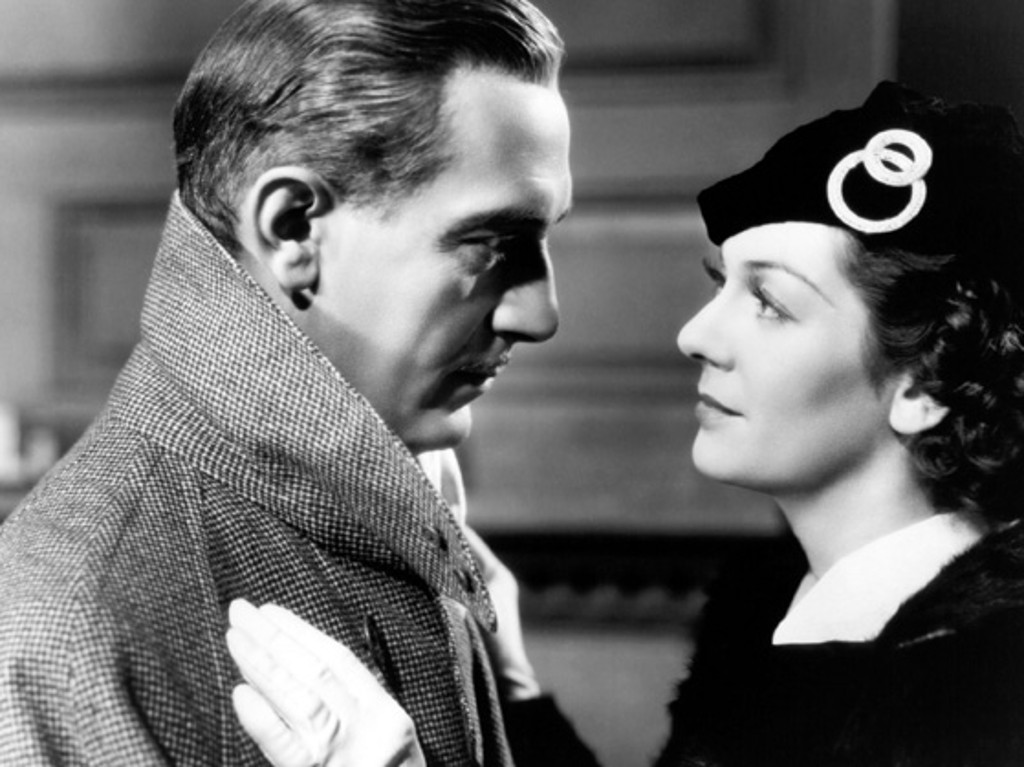
A decent mystery with some good character actors showing up - the always
entertaining Eric Blore as his butler (he had a career playing English butlers),
Leo G Carroll (Waverly in The Man from Uncle tv show) also as a butler,
a short appearance from William Demarest as an auctioneer and if you look
really closely that is Keye Luke as the Chinese pidgin speaking employee
in the casino. At the same time, he was appearing in his first Charlie Chan
film. Heath who is often played by Eugene Pallette, depending on the
studio, is played by Ted Healy - a very popular entertainer at the time though
from the few times I have seen him in films, I can't imagine why - but he
is credited with bringing the Three Stooges together - either a blessing
or a curse depending on your point of view!
One interesting aspect was the use of heavy water in the plot (being produced
in a makeshift lab in the basement!)- I can't imagine this was well known
at the time as it was only first produced in 1932.
The Garden Murder
Case (1936) – 5.0

Where there is fire, there is Philo. But which Philo. There have been so
many. Another actor takes on the role of Philo Vance in this MGM production.
It seems that no one wanted to play him very often either at MGM or at Paramount.
I can't say I had ever heard of Edmund Lowe and after this film I can see
why. He takes up space but not much more; kind of a poor man's Ronald Colman.
Fortunately two of the co-stars make up for it - the always entertaining
Nat Pendleton as Sgt. Healy. Healy in all the films is a little slow of thought
and Pendleton almost always played dimwitted character so it was a good
match. Also, playing the romantic foil to Vance is Virginia Bruce who I
keep running into recently. Quite the fragile chiseled blonde face with
the bedroom eyes. She never quite made it out of B films though she often
appeared on the verge of doing so but she is always a welcome addition.

Taken from an S.S. Dine novel, it feels like they must have simplified
it down to almost nothing that makes much sense. I think I figured out the
method of the killing about 55 minutes before Vance does and the film runs
a neat 60 minutes. At a race track a jockey in a daze keeps telling everyone
that he is going to fall and break his neck and manages to do so. Gene Lockhart
who almost always plays amusing rich guys plays a swinish rich guy this
time who everyone hates except his swinish mother (Jessie Ralph) who would
just as well rip your head off as not. When he is murdered no one in the
audience is surprised. Though I knew the method, I wasn't so sure about
the who - and it was a bit of a surprise.

Also on hand is Benita Hume as the blackmailing nurse. Hume had been married
to both George Sanders and Ronald Colman - so she clearly had something
going for her - and H.B, Warner, Kent Smith (Cat People and Curse of the
Cat People) and Grant Mitchell. All familiar faces. In his last appearance
in the Philo Vance films is the coroner played by Etienne Girardot, who
had played the same ornery character in The Dragon Murder Case and The Kennel
Murder Case. This is ok - but Lowe just doesn't add much zip to it and this
film needed some zip.
The Gracie Allen
Murder Case (1939) - 7.0
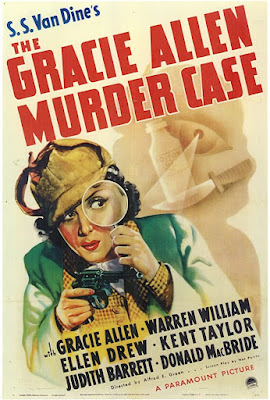
I was finally able to track down this Fido Vance mystery film. I mean Philo
Vance. It had eluded me in the same way that common sense always eludes Gracie
Allen. This is certainly the strangest Philo Vance film as they team up Philo
as played by Warren William with the constant stream of nonsensical non-sequiturs
that emit from Gracie. She actually plays Gracie Allen in the film though
no George is in sight. He had been cast initially as the murder suspect but
he and Gracie decided it was best for her to be on her own - one of the very
rare times they did not appear together - George knew where his bread was
buttered. She does her schtick from the moment we meet her speaking
to a non-existent crowd till the wonderful mixing of hands ending - a well-known
vaudeville routine. While George Burns would just let her go on one of her
never-ending monologues of confusion while he smiled, smoked a cigar and
stared at the camera, poor Philo and the rest of the characters look
as if their heads will screw off. This is her film much more than for William
- he doesn't even show up till nearly at the halfway mark and often looks
lost when he is on screen. If they had been able to put Hitler into a room
with Gracie for an hour he would have surrendered.
Vance "Now why did someone bring a dead body to the nightclub" Gracie "They
have a wonderful floor show".
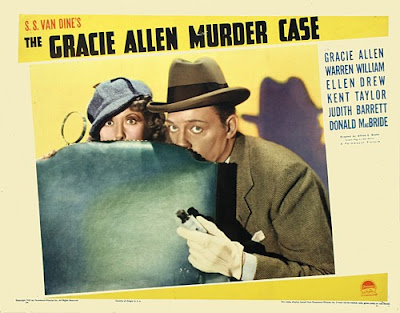
I thought who the hell in Hollywood came up with this loony idea. Well, it
turned out to be a book from S.S. Van Dine the, author of all the books,
and this one was his second to his last of twelve novels. But it was Paramount
that came up with the idea and went to him for the story. Then Nat
Perrin who was behind Duck Soup, Hellzapoppin and Song of the Thin Man turned
that into a wacky script that had me in stitches constantly. I love Gracie
Allen. Always have. The Burns and Allen Show is genius. If you dissect her
constant head turning rapid fire dialogue, it is brilliant and has perfect
timing. It is the sort of comedy that died along with vaudeville and the
1950s comedy shows. Nobody could do it today. Now I wasn't sure if I could
deal with 78 minutes of it but I never stopped laughing. Which is something
I never thought I would say in a Philo - she calls him Fido - Vance film
which are always light mysteries but not comedies. I think I could watch
this again just to get all the dialogue I missed. It comes at you at light
speed. Warren William looks flabbergasted throughout never sure how
to react to Gracie's utterances that may or may not have been in the script.
He had played Philo way back in 1934 in The Dragon Murder Case. Since then
he had been Perry Mason a few times and had just begun his series of the
Lone Wolf.
To Gracie "What was that?". "What was what". "What you were just saying".
"I don't know, I wasn't listening".
The plot. Hmmm. Well. Hmmm. Gracie finds a dead body in the office of the
Silver Slipper nightclub and manages to incriminate the man she is with.
His girlfriend hires Philo to investigate. Gracie tags along. And manages
to incriminate Philo for another murder. That is basically it with one routine
after another. For me this was sweet music but it is a terrible mystery if
that is what you are looking for and people's tolerance for her unique brand
of humor will differ. A fine cast with her - Donald MacBride, William Demarest,
H.B Warner, Jerome Cowan and Ellen Drew. Directed by Alfred Green.
'I'll get you a waiter". "Make it two, I'm starved"
Calling Philo Vance (194O) – 6.0
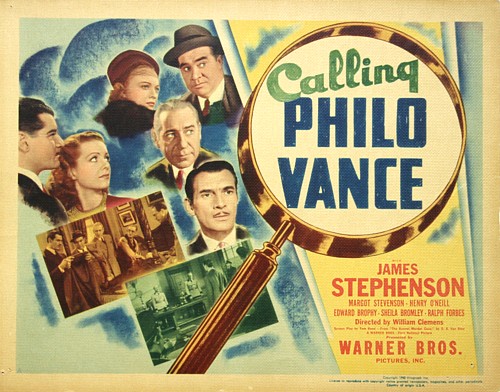
This is a remake of the earlier Philo Vance film, The Kennel Murder Case
made in 1932 with William Powell as Vance. This being 1940 though the film
throws in a spy angle with Vance working for the State Department to stop
some top secret plans from being stolen by Germany or Japan or Italy. It
may have only been 1940 but we already knew who are enemies were. The Italian
is mentioned to have been in the Ethiopian campaign, while the Chinese woman
had her area in China over run by the Japanese and is now working for them
and at the beginning of the film, Vance is in Vienna, clearly Nazi held.
Munitions manufacturers are willing to sell to the highest bidder even if
against the law.
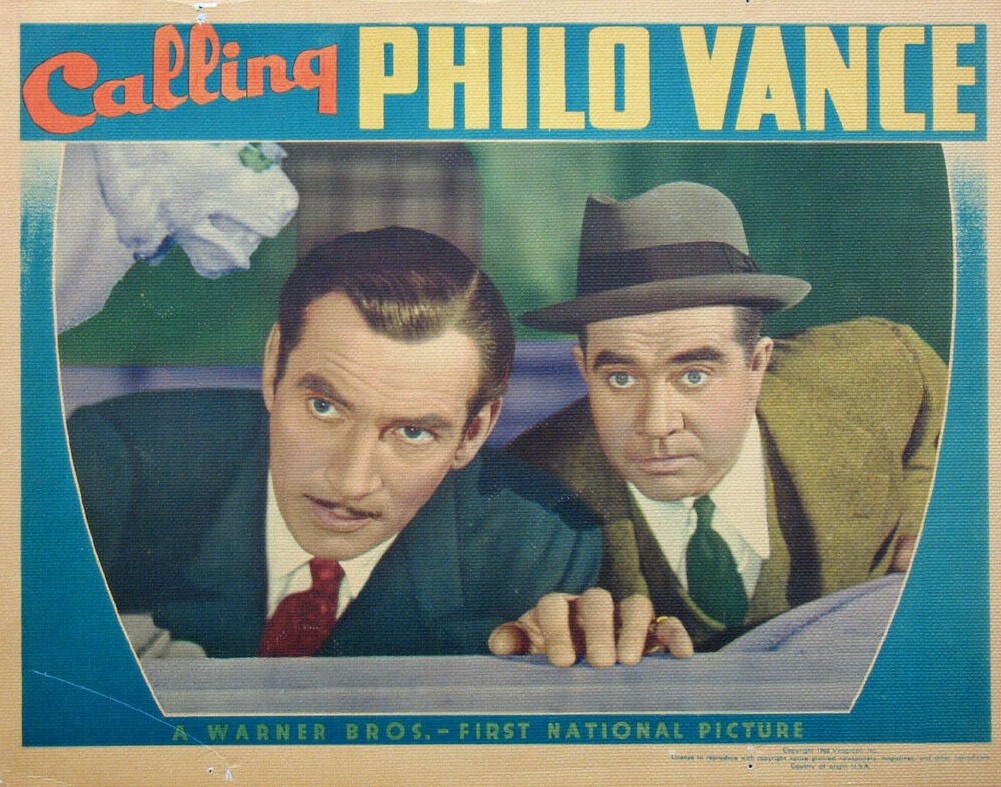
The murders themselves though play out almost exactly in the same way they
did in The Kennel Murder Case and with the same ending. But this comes in
about 11 minutes shorter than the previous film, so it is rushed with things
cut out - for example the whole scene at the kennel and the dead dog - thus
not being able to call it the Kennel Murder Case! In those pre-video days
I guess doing a remake only eight years later made sense. How many people
remembered the plot of the 1932 film? This is a very good Warner Brothers
B film that moves quickly and smoothly.
Between this film and the 1936 The Garden Murder Case were two other Philo
Vance films produced by Paramount that are either lost, never released to
video or very difficult to get your hands on.
1.The Scarab Murder Case (1936) with Wilfrid Hyde-White (lost film)
2. Night of Mystery (1937) (based on The Greene Murder Case) with Grant
Richards - sold to MCI and never released.
James Stephenson is a very credible Vance with his urbane British manner.
The reason you have likely never heard of him is that he didn't make his
film debut until 1937 at the age of 49 and was to die a mere 4 years later,
but he still has 40 credits. A real shame as he has a bit of that British
class about him.
Philo Vance Returns
(1947) – 6.0
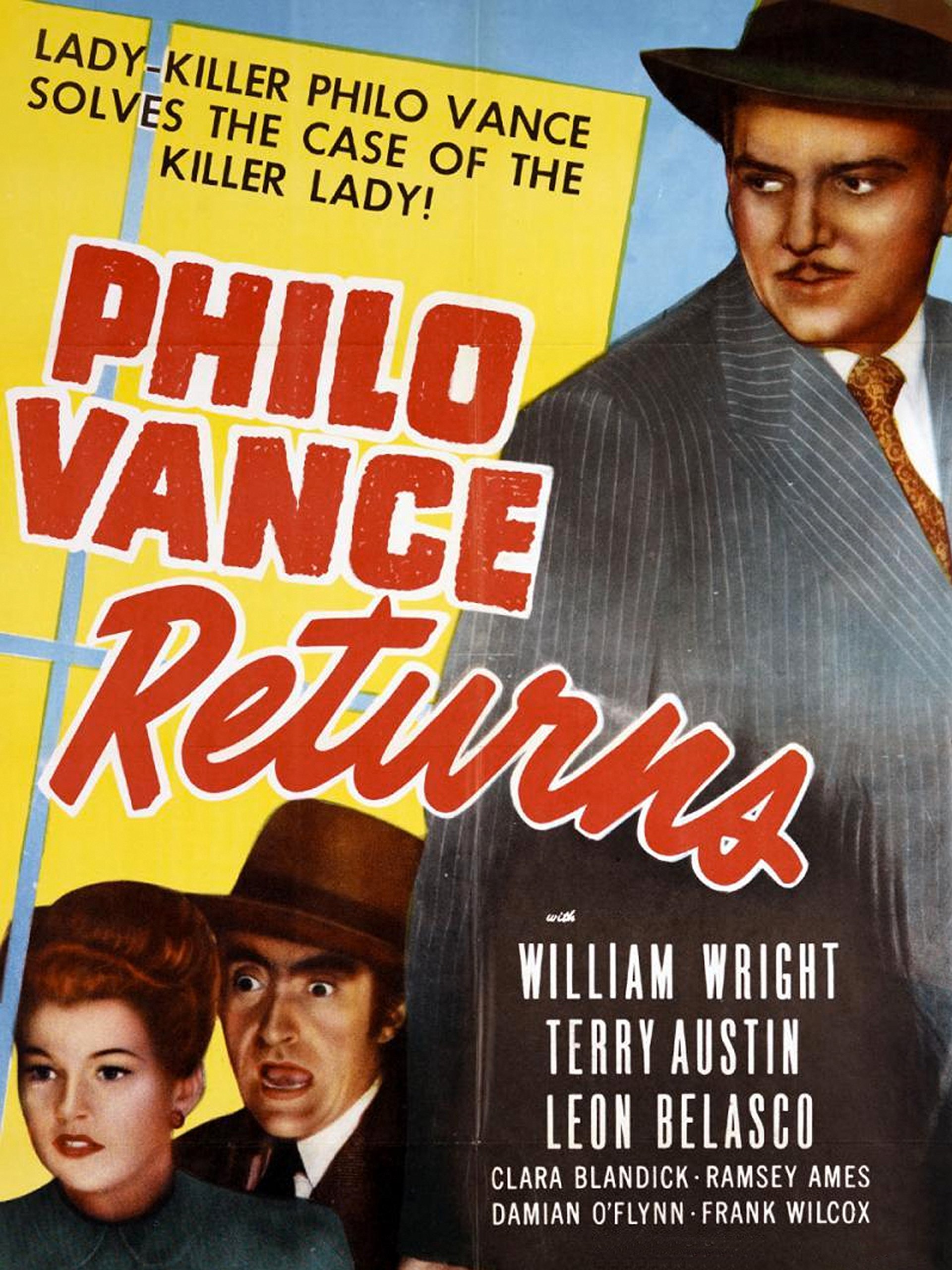
Well considering that I didn't know anyone in the cast and that this is
clearly a B film, it isn't totally bad at all and that is probably due to
the direction of William Beaudine, who directed more B films than you would
ever want to watch. A decent script as well leads to multiple murders, a few
witticisms and many suspects. By 1947 the Philo Vance books had come to an
end (last one in 1937) and the previous film with Philo as a character had
been 7 years before. The Philo Vance character here shares practically no
traits with the earlier films or the books. For one thing he lives in a crummy
hotel room so I guess Vance has come down in the world since his Penthouse
days. He also dresses in bad suits and has a working class accent. Hard to
understand why the producers would pay for the rights to Philo Vance and
then make him nothing like the character. Vance in this one is played by
William Wright. Apparently, during the war Columbia tried to market him as
the next Gable but it didn't take and he sank into obscurity faster than a
drowning man in a hurricane. By 1950 he was out of the picture business.
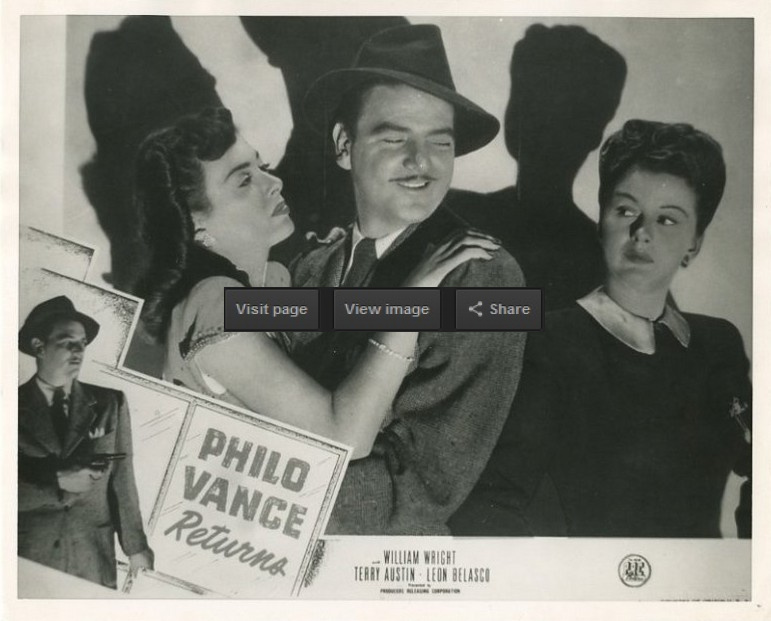
This is pretty much a straight ahead solving of the crime without Vance's
psychological analysis of the suspects which the books were based on. Still
a quick moving film of some small merit. It just looks so darn cheap though.
Larry, a friend of Vance, meets a singer and immediately wines and dines
her and proposes marriage and takes her mom to meet sweet old Grandma. Grandma
shows her the Rogues Gallery - all the ex-wives and a fan fan dancer that
he almost married. Well, no point in paying salaries in a B movies and so
in quick succession the fiancée, Larry and one of the ex-wives are
written out of the script with murder. More to come. Not sure it made much
sense when you get to the end but it isn't too bad getting there. One of
the ex-wives is played by Vivian Austin, a dish for sure - she had been voted
Miss Hollywood - but you have not heard of her because she had to quit the
business when she became blind this same year. But not before she starred
in the next Vance film. Many years later she found a doctor who cured her
and she married him. Nice ending.
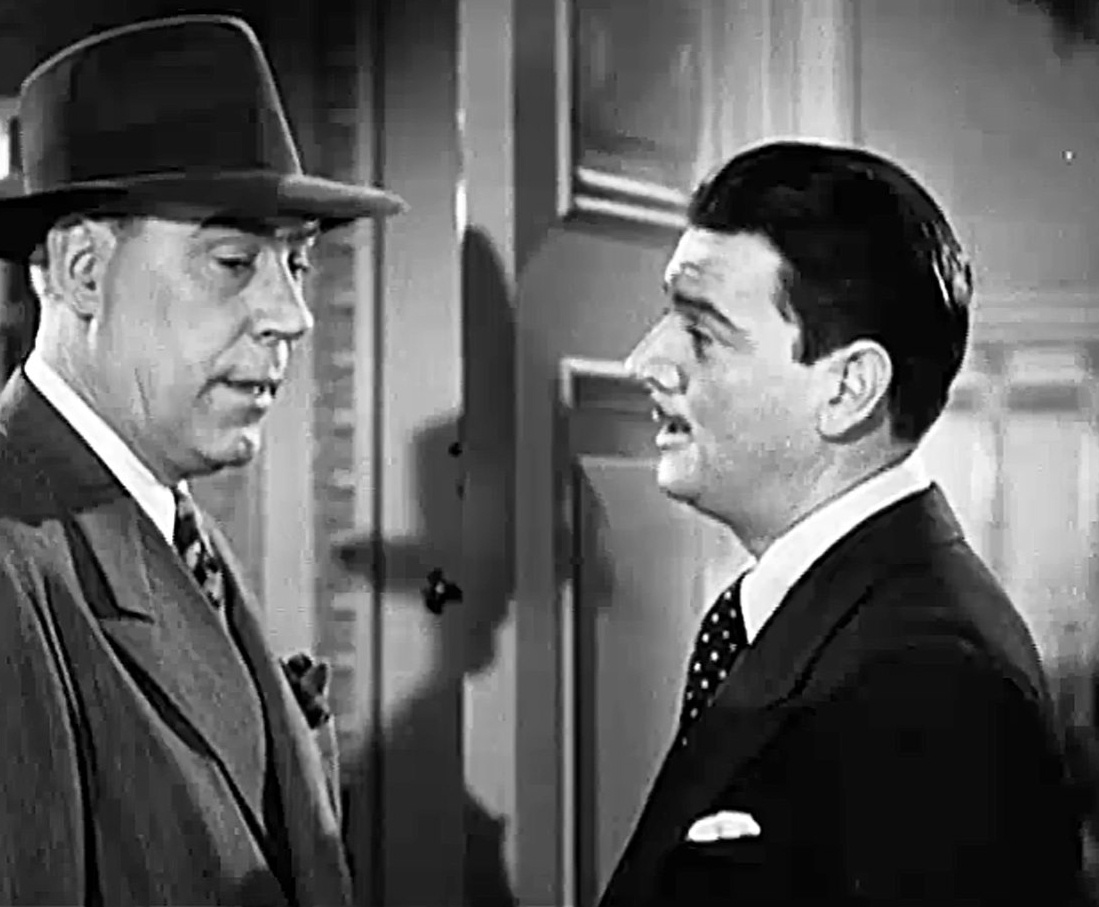
These last three films are produced by the Poverty Row studio PRC, one
of the better studios under that label. They made 179 films all on the cheap
but some of them are not bad at all. Edgar G Ulmer directed 3 films for
them, Sirk made one film for them and The Devil Bat with Bela Lugosi was
one of theirs.
Philo Vance’s
Gamble (1947) – 6.0
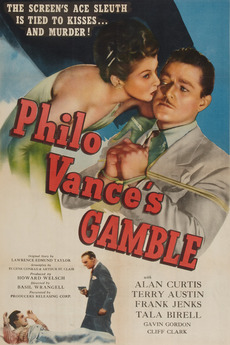
Another low budget entry in the three B films that PRC produced in the
Philo Vance series. This one is a slight upgrade from the previous PRC film
both in production values and in Vance. This time it is Alan Curtis as Vance
and he has a bit more spit and polish than William Wright did. And Vance
is at least living in a decent apartment though still a step down from the
old days. Curtis was to die at the early age of 43 in 1953 after a surgery.
The only other film I have seen him in besides the Vance films was the terrific
noir Phantom Lady, where he plays the husband suspected of killing his wife.
There are at least a couple other names I know in this one - the always oily
Dan Seymour, Frank Jenks as Vance's garrulous sidekick and the femme fatale
is played by Vivian Austin, who was in the previous Vance film.

This one has the requisite numbers of murders, mystery and suspects as
it involves a jewel swindle that ropes Vance into the case. That and a beautiful
brunette. All the initial Philo Vance films were based on specific books
but by this time there were no more books so PRC came up with their own scripts
which are surprisingly good though any resemblance to the Philo Vance of
the books is purely accidental. It has a decent script and the acting is
fine.
Philo Vance’s
Secret Mission (1947) – 5.5

This is the final of the three Philo Vance films that were produced by
Producers Releasing Company, a low budget Poverty Row company during the
1940's. It at least has a little continuity from the previous one with Alan
Curtis still as Vance and Frank Jenks as his sidekick. It is a decent enough
script with a lovely girl in the picture, Sheila Ryan. Vance is called in
to write a book about a true murder that happened seven years previously,
but the man who wants it is murdered. There is a room full of suspects and
one of them is trying to kill Vance. This was truly the end of Philo Vance
- derived from a series of popular books and then a series of films starring
a number of different good actors as Vance - William Powell, Basil Rathbone,
Paul Lukas and William Warren. No American versions of Philo have came after.
It is hard to see Philo Vance being picked up again with his books and his
films pretty much forgotten.
